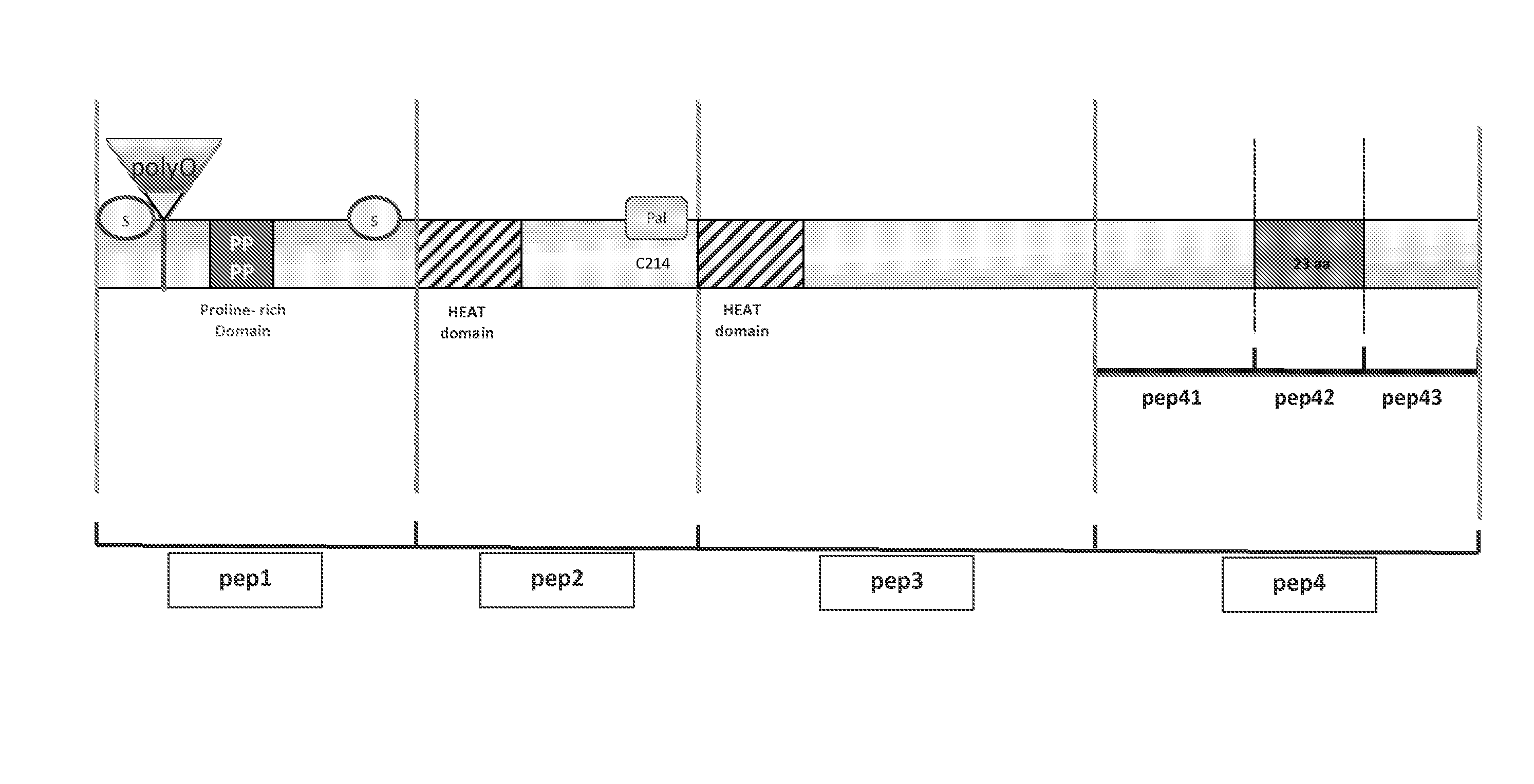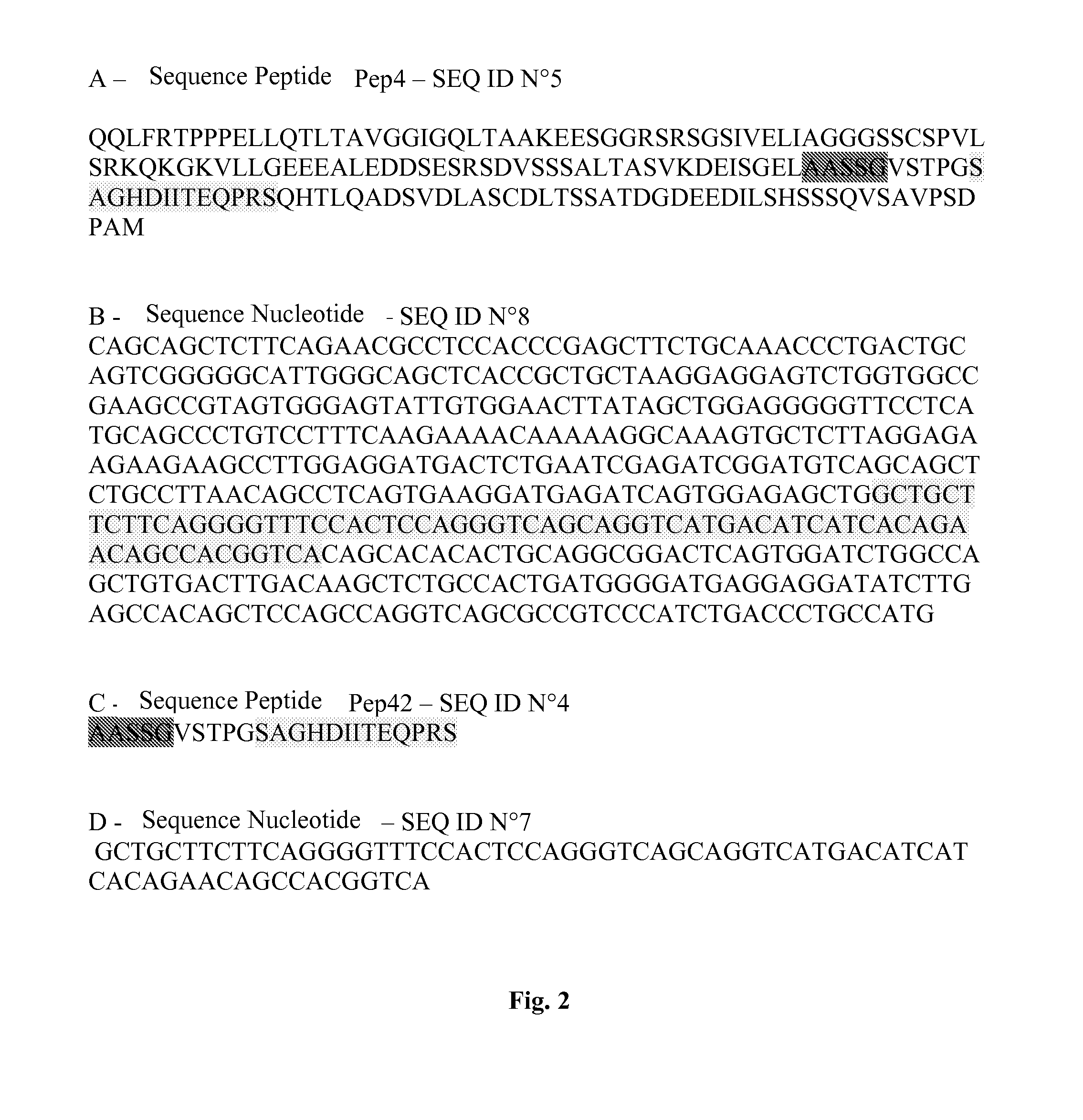Therapeutic peptides and use thereof against huntington's disease
a technology of peptides and peptides, which is applied in the direction of peptide/protein ingredients, peptide sources, and metabolic disorders, etc., can solve the problems of inducing neuronal disorders in the brain, reducing the life expectancy of the affected person, and no effective treatment of this disease, so as to achieve high efficiency and selective effect, low toxicity
- Summary
- Abstract
- Description
- Claims
- Application Information
AI Technical Summary
Benefits of technology
Problems solved by technology
Method used
Image
Examples
example 1
Identification of Peptides Inhibiting polyQ-hHtt Aggregation
[0054]Various peptides contained in the 548aa of the human Huntingtin N-terminal fragment have been cloned by Gateway in expression vectors in pcDNA type cultured HeLa cells. Each peptide was tagged either by Myc or by Cherry at its N-terminal end. These various peptides were tested by cotransfection in HeLa cells in the presence of a pcDNA vector expressing a GFP-polyQ-hHtt protein (see FIG. 5). In these experiments, the polyQ-hHtt protein tested corresponded to an hHtt protein covering 171 aa and containing an extended polyQ with a GFP tag at its N-ter end (GFP-hHtt171aa-136Q). The HeLa cells were cultured in 6-well boxes and transfected by 1.5 μg of total DNA, using JetPei (Qbiogene) reagent. Equivalent quantities of expression vectors (polyQ protein and peptides) are used for the cotransfections. When necessary, pBluescript is used to balance the quantity of DNA. Aggregation of GFP-hHtt171aa-136Q is visualised by immuno...
example 2
Inhibiting Properties of pep42 on polyQ-hHtt Aggregation in the Drosophila
[0055]The pep4 and pep42 peptides identified as inhibitors of polyQ-hHtt aggregation in HeLa cells were cloned using the Gateway technique in Drosophila pUASt expression vectors, allowing the expression of N-terminal 6Myc- or GFP-tagged peptides.
[0056]Transgenic flies expressing these peptides were constructed by injecting vectors in Drosophila embryos. The UAS / Gal4 system (Brand and Perrimon, Development 1993) was used to express these peptides at specific times and in specific tissues, in the presence of an HA- (hemagglutinin) tagged UAS-polyQ-hHtt vector.
[0057]The MS1096-Gal4 driver was used to express the HA-hHtt171aa-136Q protein (detected by an anti-HA antibody) in the salivary glands, in the absence or presence of the GFP-pep42 peptide. In the presence of the GFP-pep42 peptide, detected by an anti-GFP, the polyQ-hHtt protein loses the ability to aggregate. Salivary glands from dissected third instar lar...
example 3
Quantification of Aggregates by Filtration
[0058]a) Using HeLa Cells.
[0059]Protein extracts were obtained according to (Sittler et al., Mol Cell. 1998) with the following modifications: after transfection, the cell pellets are treated with DNase and resuspended in 150 μl 1% SDS and 50 mM DTT in PBS. The samples are boiled for 5 minutes. Two 150 μL aliquots corresponding to independent experiments were filtered together and each point was reproduced 3 times.
[0060]b) Using Salivary Glands.
[0061]The glands from 3 third instar larvae were dissected and crushed in 30 μL of 2% SDS and 50 mM DTT, then denatured for 7 minutes at 98° C. The samples are then diluted in 200 μL of 0.1% SDS before filtration. For each genotype, the samples were duplicated.
[0062]The samples were filtered on a cellulose acetate membrane (0.2 μM, Schleicher and Schuell) using a Biorad Dot-blot apparatus. The membranes were then subjected to immunodetection with an antibody, either anti-GFP polyclonal for the HeLa ce...
PUM
| Property | Measurement | Unit |
|---|---|---|
| Composition | aaaaa | aaaaa |
Abstract
Description
Claims
Application Information
 Login to View More
Login to View More - R&D Engineer
- R&D Manager
- IP Professional
- Industry Leading Data Capabilities
- Powerful AI technology
- Patent DNA Extraction
Browse by: Latest US Patents, China's latest patents, Technical Efficacy Thesaurus, Application Domain, Technology Topic, Popular Technical Reports.
© 2024 PatSnap. All rights reserved.Legal|Privacy policy|Modern Slavery Act Transparency Statement|Sitemap|About US| Contact US: help@patsnap.com










